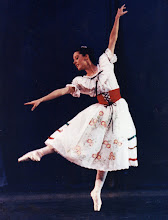There are many things that can be considered in order to make barre exercises more interesting and beneficial to your students. In my last post, Anatomy of a Ballet Combination, I did mention that using épaulement (shouldering, meaning arm and head movements) is important to include in combinations at the barre so the dancers don’t look uncomfortable dancing in the center. Since I wrote that post I’ve thought of more things to add that can make your barre combinations really dance!
Change feet. It’s easy to get caught in the en croix crutch. One tendu en croix, one degagé en croix, etc. But en croix gets boring, and the pattern doesn’t make the dancer use their minds as well as their bodies. I love combinations that shift weight and change feet. For example, you could do a tendu combination and have the pattern be front, side, (change leg) - inside leg front, (change leg again) - back. Or you could do front, inside leg back, outside leg side, and inside leg side, and then reverse.
Along these same lines, you can work the outside leg and turn the body ¼ away from the barre to work in éffacé devant, or ¼ into the barre for croisé devant. The same is true for working to the back. You can also change directions entirely, moving the body to face the barre at one point in the combination, perhaps moving through promenade in attitude or arabesque, and finishing on the second side where you’re ready to begin everything on that side.
One of my favorites was always pirouettes at the barre. At first this is tricky because you’re afraid you’re going to hit your knee on the barre, so it may be helpful to begin with the foot on the ankle or calf rather than at the knee at first. Becoming comfortable doing pirouettes at the barre makes doing them in the center infinitely easier. It’s like having a permanent partner right there; one that you know will be there when you come around at the end of the turn. You can add pirouettes to practically any barre exercise, but I think it makes more sense to do this toward the middle to end of barre rather than at the very beginning.
Fouetté turns are commonly done at the barre during rond de jambe en l’air exercises. You can also do pirouettes en dehors or en dedans during degagés, rond de jambe, frappé, or grand battement. Flic flacs are great for adding turns during frappé. And in pointe class, doing turns at the barre really helps build a dancer’s confidence before moving into the center.
One last thought and I’ll close this post. If you’re short on time and want to move from one side of the barre to the next without stopping in between sides, there are tons of ways to make the transition to the other side more fun. You can do tombé pas de bourrée to 5th position away from the barre and still facing the side you were working on, then detourné ½ turn toward the back leg, and tombé pas de bourrée to 5th position on the other side to finish at the barre, ready to begin the second side.
And another plug for my new book! Classical Ballet: Combinations for Ten Complete Advanced Classes.





No comments:
Post a Comment